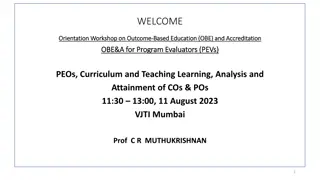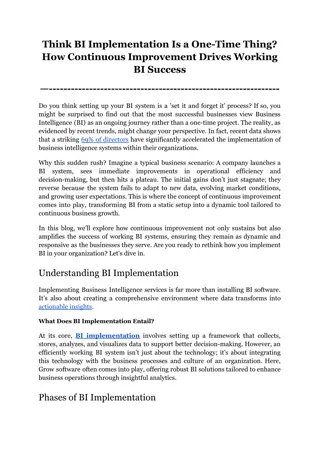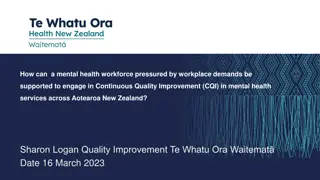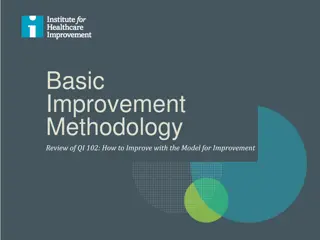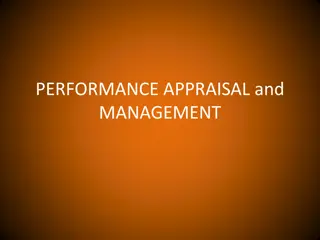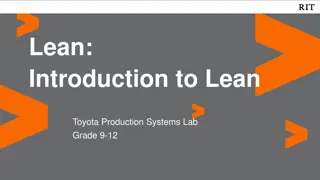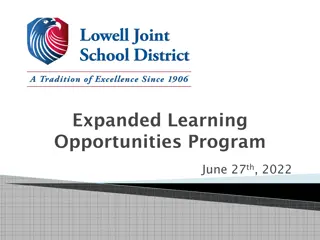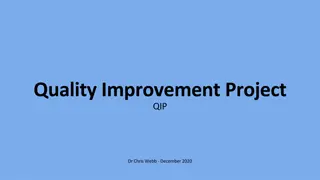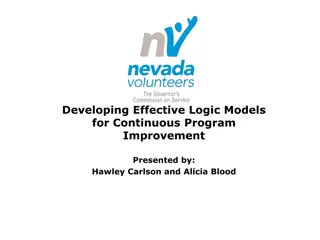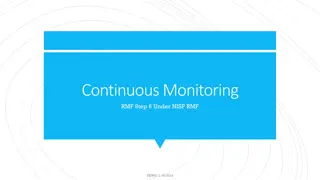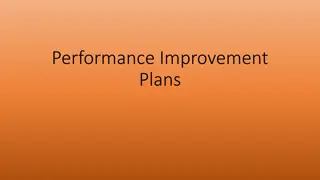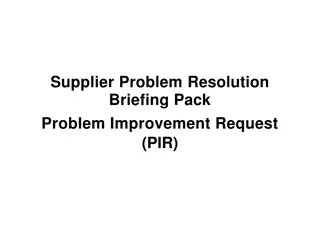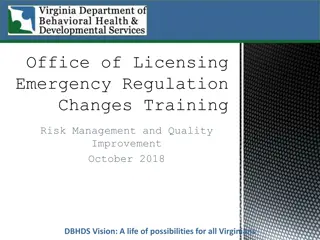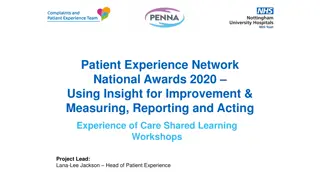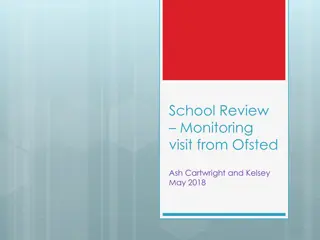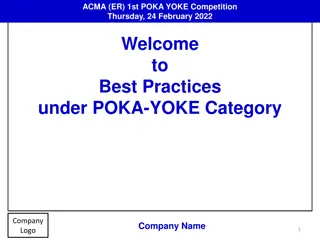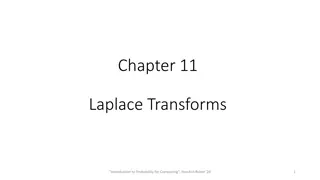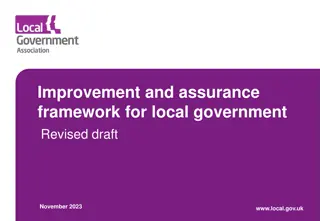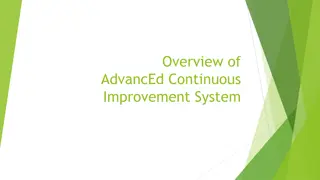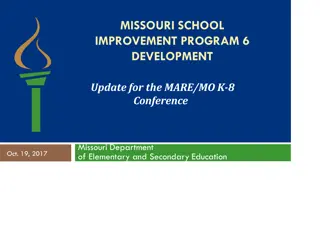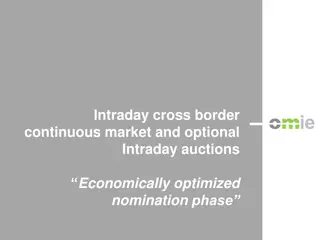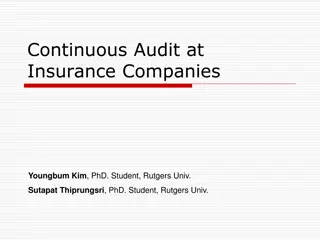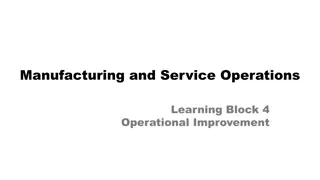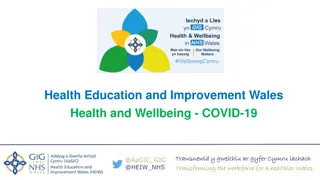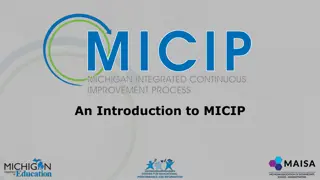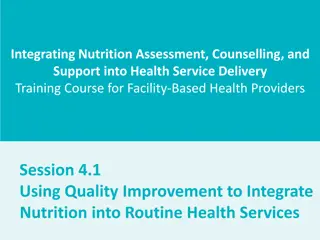Continuous Energy Improvement (CEI)
How to improve energy efficiency in your facility and stay energy smart with Continuous Energy Improvement (CEI) strategies.
0 views • 33 slides
Understanding Outcome-Based Education (OBE) and Accreditation for Program Evaluators Workshop
Explore the framework of OBE and accreditation, focusing on defining program outcomes, assessing outcomes, and continuous improvement through evaluation guidelines and reports. Learn about quality improvement in education through curriculum design and attainment analysis. Discover how to measure stu
4 views • 115 slides
Enhancing Workplace Safety Through Safety Kaizen Methodology
Safety Kaizen is a continuous improvement approach focused on identifying and addressing safety hazards to create a safer work environment. It involves steps such as problem identification, root cause analysis, brainstorming solutions, implementing improvements, monitoring progress, and involving em
1 views • 5 slides
Learn Past Continuous Tense - Grade 6 English Lesson
This Grade 6 English lesson focuses on understanding and correctly using the past continuous tense. It covers the rules for forming the past continuous tense, examples of its usage, and an assessment to test comprehension. Students will practice talking about actions happening at specific times in t
4 views • 6 slides
Europe Continuous Bioprocessing Market
The Europe Continuous Bioprocessing Market is expected to grow at a CAGR of 19.1% from 2023 to 2030 to reach $206.1 million by 2030. Continuous manufacturing is an emerging trend spanning various industries. From automotive to paper, businesses are embracing continuous manufacturing to enhance effic
3 views • 2 slides
Think BI Implementation Is a One-Time Thing_ How Continuous Improvement Drives Working BI Success
Discover why treating Business Intelligence (BI) implementation as a one-time project can limit its potential in our latest blog. We explore how continuous improvement is essential for maintaining the effectiveness and relevance of working BI systems, ensuring they adapt and grow with your business
1 views • 6 slides
Understanding Types of Production Systems: Intermittent vs. Continuous
Types of production systems are categorized into Intermittent Production System and Continuous Production System. In Intermittent Production, goods are produced based on customer orders in a flexible and non-continuous manner, allowing for a variety of products. Examples include goldsmiths making or
10 views • 17 slides
Supporting Mental Health Workforce Engagement in Continuous Quality Improvement
Staff engagement in Continuous Quality Improvement (CQI) is crucial for enhancing mental health services. Key enablers include clear aims, sustained commitment, adequate resources, leadership training, and empowering communication. Structural considerations involve centralizing CQI efforts, providin
1 views • 9 slides
Improving Quality with the Model for Improvement
In this content, we delve into the Model for Improvement methodology, focusing on key aspects such as setting aims, choosing measures, developing and testing changes. It discusses the three questions in the Model, elements of an effective aim statement, types of measures, and utilizing change concep
1 views • 27 slides
Comprehensive Guide to Performance Appraisal and Management
Performance appraisal is a key process involving assessment, goal setting, feedback, and improvement strategies for individual and organizational growth. It includes setting benchmarks, assessing training needs, communication enhancement, and determining the effectiveness of HR programs like recruit
1 views • 32 slides
Understanding Lean Manufacturing: A Comprehensive Overview
Lean manufacturing is a strategic approach focused on continuous improvement and waste elimination in processes. Originating from Henry Ford's assembly line, it evolved with Taichi Ohno and Kiichiro Toyoda into the Toyota Production System. Lean emphasizes efficiency, effectiveness, and continuous i
1 views • 8 slides
Expanded Learning Opportunities Program Overview
The Expanded Learning Opportunities (ELO) Program is designed to cater to the academic, social, emotional, and physical needs of students through engaging learning experiences outside regular school hours. This program encompasses before school, after school, summer, and intersession learning activi
1 views • 8 slides
Importance of Quality Improvement Projects in Medical Training
Trainees in medical fields are urged to engage in Quality Improvement Projects (QIPs) to enhance patient care, safety, and clinical effectiveness. These projects involve identifying areas for improvement, implementing changes, and measuring the impact of interventions. QIPs are emphasized in medical
0 views • 30 slides
Navigating Life's Journey: Education, Growth, and Success
Embark on a journey through life's stages, from early childhood to retirement, emphasizing the importance of education, skills, and hard work for achieving success. Key messages include the correlation between high skill and high reward, the value of punctuality, participation, and attendance, as we
0 views • 14 slides
Developing Effective Logic Models for Continuous Program Improvement
Explore the essentials of logic models and their significance in evaluating programs for continuous improvement, presented by Hawley Carlson and Alicia Blood. Learn about theory of change, logic model components, and using logic models for evaluation planning.
4 views • 12 slides
Understanding Continuous Monitoring in Risk Management Framework (RMF)
Explore the continuous monitoring process in the Risk Management Framework (RMF) under the NISP RMF FISWG. Learn about the six steps in the RMF process, DSS-provided RMF guidance, and an overview of RMF continuous monitoring strategies and security control families. Discover how to outline DSS RMF p
1 views • 25 slides
Utility Performance Improvement Strategies
Effective utility performance improvement involves benchmarking, selecting key performance indicators (KPIs) aligned with strategy, developing improvement plans, and implementing initiatives to achieve targets. This process entails identifying focus areas, setting improvement targets, and implementi
0 views • 37 slides
Supplier Problem Resolution Briefing Pack - Problem Improvement Request (PIR)
The Problem Improvement Request (PIR) process is essential for addressing non-conformances, quality escapes, customer complaints, delivery issues, and product rejections. It focuses on identifying root causes, implementing corrective actions, and preventing future recurrences. Suppliers are encourag
0 views • 5 slides
Oregon District Continuous Improvement Planning Process
Explore the key components of Oregon's district continuous improvement planning process, including objectives, executive memos, ODE commitments, and the essential elements that all Oregon districts must incorporate into their continuous improvement plans. Learn about the shifts in the overarching vi
0 views • 9 slides
Regulatory Changes and Quality Improvement in October 2018
The content discusses regulatory changes related to risk and quality improvement in October 2018, focusing on serious incidents, reporting requirements, risk management, and monitoring service quality. Providers are mandated to review, analyze trends, identify systemic issues, recommend remediation,
0 views • 31 slides
Patient Experience Network National Awards 2020: Driving Quality Improvement
The Patient Experience Network National Awards 2020 recognized efforts in improving patient experience through insights, measurement, reporting, and action. Based in Nottingham, the organization serves millions of residents and provides specialist services. Their Complaints and Patient Experience Te
0 views • 9 slides
Key Driver Diagrams in Continuous Quality Improvement
Key Driver Diagrams are essential tools in Continuous Quality Improvement (CQI) to help organizations achieve their goals by identifying key drivers and their relationships. These diagrams aid in understanding complex systems, setting SMART aims, and implementing effective change strategies. Through
0 views • 24 slides
School Review and Improvement Recommendations from Ofsted Visit
The Ofsted visit highlighted key areas for improvement at the school, emphasizing the need for a richer and more comprehensive curriculum, higher expectations for all students, and improved standards in mathematics. The priorities outlined focus on leadership effectiveness, teaching quality, persona
0 views • 11 slides
ACMA (ER) 1st Poka Yoke Competition Highlights
Welcome to the ACMA (ER) 1st Poka Yoke Competition held on Thursday, 24th February 2022. The event showcased best practices in Poka-Yoke categories, focusing on themes like Quality Improvement, Safety Improvement, and Cost Reduction. Participants presented innovative solutions aimed at addressing ke
0 views • 18 slides
Understanding Laplace Transforms for Continuous Random Variables
The Laplace transform is introduced as a generating function for common continuous random variables, complementing the z-transform for discrete ones. By using the Laplace transform, complex evaluations become simplified, making it easy to analyze different types of transforms. The transform of a con
0 views • 17 slides
Kentucky Department of Education School Improvement Efforts
The Kentucky Department of Education focuses on school improvement efforts through Comprehensive Support and Improvement (CSI), Targeted Support and Improvement (TSI), and Additional Targeted Support and Improvement (ATSI) programs. Schools undergo a statutory and regulatory process as per state law
0 views • 7 slides
Improvement and Assurance Framework for Local Government - November 2023
Local authorities play a crucial role in their own performance and improvement, guided by the sector-led improvement approach. This framework emphasizes accountability, transparency, and continuous improvement, supported by tools and resources provided by the LGA. Assurance and accountability mechan
0 views • 18 slides
Understanding Probability Density Functions for Continuous Random Variables
Probability density functions (PDFs) are introduced for continuous random variables to represent the likelihood of events in a continuous space. Unlike discrete probability mass functions, PDFs operate with integration instead of summation, ensuring total probability is 1. Consistency and differenti
0 views • 32 slides
Transforming Education Through AdvancEd Continuous Improvement System
Explore the journey of education and accreditation as ongoing processes, supported by AdvancEd Performance Standards and Continuous Improvement System. Learn about the tools, resources, and technology platforms provided to institutions for evaluating and driving institutional transformation. Discove
1 views • 13 slides
Overview of Different Types of Fermentation Processes
Explore the various types of fermentation processes including batch fermentation, fed-batch fermentation, continuous fermentation, solid-state fermentation, anaerobic fermentation, and aerobic fermentation. Each process has its own advantages and disadvantages, influencing factors such as sterilizat
0 views • 18 slides
Missouri School Improvement Program: Development Update
The Missouri School Improvement Program (MSIP) focuses on improvement drivers, policy goals, development teams, timeline, emergent themes, performance standards, and process standards to enhance the academic achievement, readiness of graduates, and overall educational experience in schools and distr
0 views • 43 slides
Coexistence of Continuous Cross-Border Intraday Markets and Implicit Auctions
Intraday cross-border continuous markets combine continuous trading with optional intraday auctions, providing participants with opportunities to trade firm energy within price areas. The coexistence of continuous trading and implicit auctions offers advantages such as market price acquisitions and
0 views • 9 slides
Continuous Audit at Insurance Companies
Creating a rule-based model for anomaly detection, this research focuses on developing an architecture for continuous audit systems. By utilizing historical data, the scope includes detecting fraud, discrepancies, and internal control weaknesses, leading to a maturity model for automated continuous
0 views • 27 slides
Operational Improvement in Manufacturing and Service Operations
Businesses prioritize cost reduction to stay competitive by implementing continuous improvement strategies. This course covers Lean practices, quality improvement tools, and techniques to enhance operational efficiency and productivity.
0 views • 29 slides
Health Education and Improvement Wales - Transforming Workforce for a Healthier Wales during COVID-19
Health Education and Improvement Wales is implementing initiatives to transform the workforce for a healthier Wales in response to COVID-19. They provide support at local, organizational, and national levels through helplines, online resources, compassion training, and access to various healthcare s
0 views • 7 slides
Understanding MICIP: A Path to Student Success
Explore the Michigan Integrated Continuous Improvement Process (MICIP) designed to enhance student outcomes by addressing whole child needs, aligning funds, fostering equity, and promoting continuous improvement through a systematic approach. MICIP emphasizes stakeholder voices, data-driven decision
0 views • 16 slides
Key Driver Diagrams in Continuous Quality Improvement
Key Driver Diagrams are essential tools in Continuous Quality Improvement (CQI) processes. They help visualize the primary drivers, change strategies, and SMART aims to achieve improvement goals. Understanding, creating, and utilizing Key Driver Diagrams play a significant role in promoting quality
0 views • 24 slides
Integrating Nutrition Assessment and Counseling: Quality Improvement in Health Services
This training course focuses on integrating nutrition assessment, counseling, and support into routine health services using quality improvement methods. Participants will learn to explain the concept of quality improvement, develop a plan for integrating nutrition services, and understand key princ
0 views • 32 slides
Continuous Improvement in Library Standards and Distance Learning Perspectives
This presentation discusses the comparison between previous and new models of library standards, focusing on continuous assessment and improvement. It highlights the key elements of mission-driven processes, measurement, and planning, emphasizing the true payoff in the third cycle. The implications
0 views • 23 slides
Utilizing Present Continuous & Verb 'Can' in English Grammar Lessons
In this English grammar lesson, students learn to use the present continuous tense for activities happening at the moment or future plans. They also understand the usage of 'can' for expressing ability positively or negatively. The rules for forming present continuous verbs and examples are provided
0 views • 9 slides

